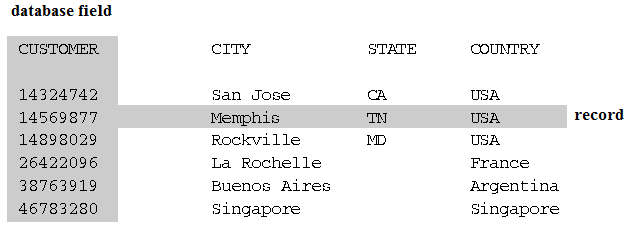dBase DBF Files
dBase DBF Files Essentials
This section
introduces dBase DBF files. It focuses on the terms and concepts that
help you use SAS/ACCESS Interface
to PC Files. For information about Visual FoxPro, see dBase DBF MEMO Files.
DBF files are in a file
format that dBASE creates. dBASE is a relational database management
system for PC systems. DBF files can be created using a variety of
PC software programs, such as Microsoft Excel.
A DBF file contains data that is organized
in a tabular format of database fields and records. Each database
field can contain one type of data, and each record can hold one data
value for each field. This picture illustrates four database fields
from Customer.DBF and highlights a database field and a record.
DBF Data Types
Every field in a DBF
file has a name and a data type. The data type tells how much physical
storage to set aside for the database field and the form in which
the data is stored. This list describes each data type.
specifies a decimal
number. The N value is the
total number of digits that are used to express the value (precision).
The n value is the number of
digits following the decimal point (scale). The maximum values allowed
depend on which software product you are using.
Numeric field types
always preserve the precision of their original numbers. However,
SAS stores all numbers internally as double-precision, floating-point
numbers so their precision is limited to 16 digits.
Note: If every available digit
in a DBF file field is filled with a 9 , SAS interprets the value
of the field as missing. If a field in SAS indicates a missing value
(represented by a period), SAS writes a nine for each available digit
in the corresponding DBF file database field. While in a SAS session
a value is represented as missing.:
specifies a floating-point
binary number that is available in dBASE IV and later versions. The
maximum N, n value
for Float is 20,18. Check with the documentation that comes with other
software products that you might be using to create DBF files to determine
whether those products support floating-point binary numbers.
Setting Environment Variables and System Options
Missing numeric values
are filled in with blanks by default. The DBFMISCH environment variable
is used to change the default by specifying the character that the
interface to DBF files uses to fill missing numeric fields. If you
try to write a SAS file with a missing numeric variable to a DBF file,
the corresponding DBF field is filled with the DBFMISCH character.
Conversely, any numeric or float field in a DBF file that contains
the DBFMISCH character is treated as a missing value when SAS read
it.
Type in any single
character. For example, to fill missing numeric values with the character
'9', enter
-set DBFMISCH 9.
Although the United
States uses a decimal separator, other countries use different symbol
characters. For example, some European countries use a comma. You
must set the CTRYDECIMALSEPARATOR= system option to enable users to
import or export data that is saved with a different decimal.
Supported SAS IMPORT and EXPORT Procedure Statements
The IMPORT | EXPORT
method uses DBF file formats to access data in DBF Files on Linux,
UNIX, and Microsoft Windows operating environments.
The method imports data
from DBF files in versions 3, 4, and 5 formats. It exports data to
DBF files with version 5 formats.
See Example 1: Export Data to a DBF File from a SAS Data Set for additional
information.
- DBENCODING = 12–byte SAS encoding-value
-
indicates the encoding used to save data in DBF files. Encoding maps each character in a character set to a unique numeric representation, which results in a table of code points. A single character can have different numeric representations in different encodings.For example, some DBF files were saved with pcoem850 encoding. When you are importing these DBF files in Microsoft Windows, specify:Interaction: The IMPORT procedure reads and transcodes data from pcoem850 to Microsoft Windows default WLATIN1.Note: Refer to the SAS NLS User's Guide for information about transcoding and valid encoding values.
Example 3: Export Data to a DBF File from a SAS Data Set Using Encoding
This example exports
data from a SAS data set named SDF.ORDERS to a DBF file named Oem850.dbf.
The procedure translates SAS data from its current session encoding,
to pcoem850 encoding and writes it to the DBF file.
PROC EXPORT DATA=SDF.ORDERS
OUTFILE="&dbfdir.Oem850.dbf"
DBMS=DBF REPLACE;
DBENCODING=pcoem850;
RUN; Example 4: Import and Translate Data from a DBF File
This example imports
data from a DBF file named Oem850.dbf, which was saved with pcoem850
encoding. The procedure reads in the data and translates it from pcoem850
encoding to current SAS session encoding.
PROC IMPORT OUT=WORK.ORDERS
DATAFILE="&dbfdir.Oem850.dbf"
DBMS=DBF REPLACE;
DBENCODING=pcoem850;
RUN;